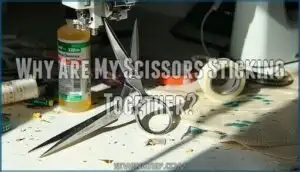This site is supported by our readers. We may earn a commission, at no cost to you, if you purchase through links.

You can fix this by cleaning the hinge area with steel wool to remove rust, applying a drop of WD-40 or machine oil to lubricate the mechanism, and adjusting the tension screw if it’s too tight.
Most scissor stiffness happens when moisture gets trapped in the joint or when adhesive residue accumulates from cutting tape.
The solution is straightforward: clean, oil, and adjust, and your scissors should glide smoothly again once you address these common issues.
Professional techniques can restore even severely damaged scissors.
Table Of Contents
- Key Takeaways
- What Causes Stiff Scissors?
- How Stiff Should Scissors Be?
- Why Are My Scissors Sticking Together?
- Does Rust Stiffen Scissor Hinges?
- Can Scissor Hinges Break?
- How Do I Fix Stiff Scissors?
- What Products Can Help With Stiff Scissors?
- What Are Tips to Prevent Stiff Scissors?
- How Do I Follow The Walkthrough?
- What is The Solution to The Game?
- Frequently Asked Questions (FAQs)
- Conclusion
Key Takeaways
- You can fix stiff scissors by cleaning the hinge area, applying a drop of oil to lubricate the mechanism, and adjusting the tension screw if it’s too tight, so you’ll be back to cutting smoothly in no time.
- To prevent future stiffness, you should clean your scissors regularly, oil them weekly if used daily, and store them in a dry place to prevent moisture damage, which will extend their lifespan substantially.
- If your scissors are rusty, you can remove the rust by soaking them in distilled white vinegar for 24 hours, then wiping them clean and applying oil to prevent further corrosion, and you’ll have your scissors working like new again.
- You don’t need to use WD-40 on your scissors, as it attracts dust and debris – instead, use sewing machine oil or specialty scissor oil for better lubrication and longer-lasting results, and you’ll be able to cut with ease and precision.
What Causes Stiff Scissors?
Your scissors get stiff when rust builds up on the blades and pivot area, dirt and fibers collect between the metal parts, or you haven’t oiled them in a while.
The pivot screw might also be too tight, making it hard to open and close your scissors smoothly, which can be caused by a lack of maintenance.
Rust
Rust sneaks into your scissors like an unwelcome guest, turning smooth cuts into a frustrating struggle. When moisture meets metal, oxidation begins its destructive work on blades and pivot points.
Moisture is your scissors’ worst enemy, silently sabotaging every smooth cut you try to make.
This chemical reaction creates that stubborn orange coating that locks up your scissor movement. Rusty scissors develop stiffness because corrosion acts like sandpaper between moving parts.
The metal composition of your scissors determines how quickly rust forms, but all steel tools are vulnerable. For vinegar rust removal, specialized products exist.
Here’s your rust removal strategy:
- Vinegar soak – Submerge rusty scissors in distilled white vinegar for 24 hours to dissolve corrosion
- Oil barriers – Apply scissor oil to create protective coating against future moisture exposure
- Rust prevention – Store scissors in dry locations and clean regularly
Don’t let rust win this battle against your cutting tools.
Cleaning & Oiling
Beyond dealing with rust, poor cleaning and oiling habits are prime culprits behind scissors stiff fix issues.
Dirt, fibers, and residue accumulate on blades, creating friction that makes your scissors work harder than they should.
Regular use of a scissors maintenance kit can help prevent these issues.
| Maintenance Task | Light Use | Heavy Use |
|---|---|---|
| Cleaning Frequency | After big projects | Weekly wipes |
| Oil Application | Monthly drops | Weekly lubrication |
| Residue Removal | As needed | Regular checks |
| Tool Maintenance | Basic cleaning | Deep cleaning |
| Oil Types | Machine oil | Specialized oils |
Regular clean scissors and oiling scissors prevents buildup that causes stiffness and extends your tool’s lifespan substantially.
Tension
The pivot screw controls your scissors’ tension, and getting it right makes all the difference between smooth cuts and hand cramps.
Getting your scissor tension just right transforms exhausting cuts into effortless snips that won’t strain your hands.
When tension’s too tight, you’ll fight every snip and experience user fatigue within minutes.
Too loose? Your blades won’t align properly, causing materials to fold instead of cut cleanly.
Test your tension by holding scissors with blades pointing up.
Open one handle to 90 degrees – the blade should drop about an inch if tension’s correct.
If it stays rigid, you need pivot adjustment.
If it flops completely, tighten that screw.
Use a small screwdriver for tension adjustment.
Turn counterclockwise to loosen stiff scissors, clockwise to tighten loose ones.
After adjusting, lubricate scissors at the pivot point with machine oil.
This simple fix improves blade alignment and cutting efficiency dramatically.
Proper blade tension is key for clean cuts.
Remember: proper tension prevents the "scissors stiff solved" search later.
Test, adjust, oil – your hands will thank you.
How Stiff Should Scissors Be?
Your scissors’ ideal resistance should feel like a firm handshake – not too loose, not too tight.
Proper tension tolerance guarantees cutting efficiency without causing user fatigue across different scissor types.
Test your scissor tension by holding them vertically and opening one blade to 90 degrees.
The blade should drop about an inch under its own weight.
This indicates balanced stiffness for precise cuts.
Here’s what proper scissor tension prevents:
- Blades misaligning and pushing material instead of cutting
- Excessive hand strain from overtightened pivot screws
- Poor cutting performance from loose, wobbly blades
Why Are My Scissors Sticking Together?
When your scissors won’t budge, adhesive buildup is usually the culprit.
Tape residue and sticky materials create a film between blades, disrupting blade alignment and making scissors sticking unbearable.
Material type affects how much residue accumulates.
Proper cutting technique helps prevent this mess.
For immediate residue removal, apply sewing machine oil to affected areas and work the blades.
To further prevent sticking, oil joints regularly to maintain smooth operation.
This scissors stiffness solutions method restores smooth operation quickly.
Does Rust Stiffen Scissor Hinges?
Metal oxidation is the culprit behind your scissors stiff solved problem.
Rust formation creates a grinding sensation that makes opening and closing feel impossible.
Hinge corrosion builds up around pivot points, causing metal-on-metal friction that locks your scissors in place.
To address this issue, consider using a specialized rust remover.
Here’s how rust impacts your scissors:
- Rust Impact: Creates sticky resistance that requires extra force to operate
- Preventative Measures: Regular cleaning and oiling stops corrosion before it starts
- Vinegar Soak: Dissolves existing rust buildup overnight for smooth operation
Scissor rust removal involves soaking in distilled white vinegar, while scissor rust prevention requires consistent maintenance habits.
Can Scissor Hinges Break?
Unfortunately, scissor hinges can break, especially when the hinge material faces excessive stress or wear.
Common breakage causes include overtightening pivot screws, dropping scissors, or forcing stiff blades open.
When scissor hinge breakage occurs, you’ll notice loose connections or complete separation.
Professional repair options exist for quality scissors, though costs vary.
Many higher-end brands offer warranty coverage for manufacturing defects.
Preventative measures like proper lubrication and gentle handling help avoid scissor hinge issues.
Regular maintenance prevents most scissor hinge repair situations from developing, but safe storage practices can also help extend their lifespan.
How Do I Fix Stiff Scissors?
When your scissors feel like they’re fighting you, start with these simple fixes to restore smooth operation:
- Oiling Techniques – Apply sewing machine oil to pivot points and work scissors open and closed until movement improves
- Tension Adjustment – Use a screwdriver to loosen overly tight pivot screws for easier handling
- Rust Removal – Soak rusted scissors in distilled white vinegar overnight to dissolve buildup
- Residue Cleaning – Remove sticky debris with soap and water, then dry thoroughly
Professional repair services handle broken hinges when home fixes aren’t enough.
To prevent future stiffness, consider regularly oiling blades.
What Products Can Help With Stiff Scissors?
Several products can restore your scissors to smooth operation.
Specialty scissor oil and sewing machine oil serve as excellent lubricant types for pivot points.
For rust removal, distilled white vinegar works as an effective rust remover when scissors soak for 24 hours.
Basic tension tools like screwdrivers help adjust pivot screws properly.
Cleaning kits with old toothbrushes remove debris from blade bases.
Some users apply protective coatings after cleaning.
Specialty adhesive remover tackles sticky residue from tape cutting, while scissor lubrication techniques using these products solve most stiffness issues, including rust removal and applying distilled white vinegar.
What Are Tips to Prevent Stiff Scissors?
You can avoid the frustration of stiff scissors by developing smart maintenance habits that keep your tools working smoothly.
Prevention beats repair every time, and these scissor maintenance tips will save you from future headaches.
Essential Prevention Strategies:
- Regular Cleaning: Wipe down blades weekly to remove lint, fibers, and debris that cause friction
- Proper Oiling: Apply a small drop of sewing machine oil to pivot points monthly for smooth operation
- Tension Checks: Test blade movement periodically and adjust the screw if scissors feel too loose or tight
- Storage Solutions: Keep scissors in dry places with protective sheaths to prevent moisture damage
- Material Choice: Avoid cutting sticky materials like tape that leave residue on blades
These scissor stiffness prevention methods work together as your defense system.
Smart storage solutions protect against rust, while regular scissor oiling methods reduce metal-on-metal friction.
Remember, scissor lubrication techniques don’t require expensive products—household machine oil works perfectly.
By following these scissor stiffness solutions consistently, you’ll extend your scissors’ lifespan substantially.
How Do I Follow The Walkthrough?
You’ll need to follow each section carefully to complete the entire process from start to finish.
The walkthrough covers seven key areas that guide you through different stages, so you won’t miss any important steps along the way, and it helps you understand complete concepts.
General Tips
Your scissors deserve better than a junk drawer fate.
Start with proper storage in a dry place to prevent rust. Check blade alignment regularly – misaligned blades create unnecessary friction.
Choose quality materials over cheap alternatives for longevity.
| Storage Method | Maintenance Task | Performance Benefit |
|---|---|---|
| Dry container | Weekly cleaning | Prevents rust buildup |
| Magnetic strip | Monthly oiling | Smooth operation |
| Protective sheath | Tension checks | Precise cuts |
| Tool organizer | Handle tightening | Comfortable grip |
Kansas
Starting your journey through Kansas requires careful preparation, much like maintaining your scissors for peak performance.
You’ll explore Kansas Cities from Wichita to Topeka while learning about Kansas Geography and Kansas Culture.
The state’s rich Kansas History parallels how proper scissors maintenance prevents scissor stiffness causes.
Just as Kansas Economy depends on agriculture and industry, your scissors need regular scissors cleaning and scissors oiling to function smoothly.
Navigate through cornfields and historical landmarks while keeping your cutting tools sharp.
This foundation prepares you for tackling stiff scissors issues effectively.
Emerald City
You’ve made it past Kansas, and now the Emerald City awaits with its dazzling green glow.
This magical destination represents the heart of your scissors maintenance journey – where Dorothy’s Journey teaches us that solutions aren’t always what they seem.
The Wicked Witch may have cursed your blades with stiffness, but Oz’s Magic holds the answers.
Just like following the Yellow Brick Road, proper scissors cleaning requires patience and the right approach.
The Flying Monkeys of neglect have left debris and rust, but you’re about to discover the wizard’s secrets to lubrication and restoring smooth scissor operation.
This journey will require understanding that proper scissors cleaning is key to maintaining your tools.
The Prison
Navigate the Prison Layout carefully to diagnose why your scissors jammed.
Check for rust accumulation in tight spaces where Guard Patrols missed regular maintenance.
Examine Resource Scarcity issues like missing oil that causes scissors tight movement.
Study Inmate Interactions between blade components – adhesive buildup creates sticking.
Plan Escape Strategies from stiffness through systematic cleaning and lubrication of pivot points.
Glinda’s Castle
You’ll encounter Glinda’s magnificent castle where her powers protect ancient secrets behind elaborate defenses.
Just like stiff scissors need proper lubrication to overcome tightness, you must carefully navigate her magical barriers.
Use wire cutters or skate blades to reveal hidden clues—these tools work similarly to how you’d address scissors stiffness with precision.
Place the ribbon on cabinet handles, untie knots with needles, then position colored balls on portal stones.
Character analysis reveals Glinda’s magic weaknesses through methodical exploration of castle secrets and magical barriers, using tools like wire cutters and skate blades to uncover hidden clues.
The Fortress
Beyond Glinda’s Castle lies your ultimate challenge. You’ll navigate the Fortress Layout while studying Fortress History to understand its mysterious construction.
The Fortress Defenses require careful attention, but knowing the Fortress Weaknesses helps you succeed where others failed.
- Ancient stone corridors echo with whispers of forgotten magic
- Towering battlements cast long shadows across mystical courtyards
- Hidden chambers conceal secrets behind ornate tapestries
The Invitation
Discovering the invitation’s purpose requires careful recipient selection and proper design elements.
You’ll navigate Mombi’s challenging puzzles using your fishing rod, cello bow, fire poker, and star chip.
Master the RSVP process through portal mechanics while following invitation etiquette.
These tools help reveal secrets just like fixing stiff scissors requires the right approach and scissor stiffness tips, and understanding the overall process is crucial for proper design.
What is The Solution to The Game?
The game objective centers on restoring your scissors to perfect working condition through systematic problem-solving. You’ve mastered the walkthrough steps, but understanding the complete puzzle solutions requires recognizing patterns in scissor maintenance.
The level design of scissor repair follows logical progression: identify the problem, apply the correct fix, test results, and prevent future issues. Your character strategies should focus on methodical troubleshooting rather than random attempts.
Here are the core hidden secrets to solving stiff scissors permanently:
- Clean debris from pivot points using cotton swabs dipped in rubbing alcohol
- Apply one drop of sewing machine oil to the screw threads monthly
- Test tension by holding scissors vertically and observing blade movement
- Store scissors in dry environments to prevent moisture-related stiffness
When your scissors won’t open smoothly, you’re dealing with a mechanical puzzle. This scissor stiffness guide reveals that consistent maintenance prevents most issues. Following these scissor stiffness tips guarantees your tools stay responsive and precise.
Frequently Asked Questions (FAQs)
Can I use WD-40 on scissors?
You can use WD-40 on scissors, but it’s not ideal.
WD-40 attracts dust and debris over time.
Instead, use sewing machine oil or specialty scissor oil for better lubrication and longer-lasting results.
How do you make scissors move smoother?
Think your scissors are beyond saving?
Clean debris from blades, oil the pivot point with sewing machine oil, and adjust tension by loosening the screw slightly.
You’ll restore smooth operation instantly.
How Often Should I Clean and Oil My Scissors?
Clean your scissors every 2-3 uses to remove debris and fibers.
Oil them weekly if used daily, or monthly for occasional use.
Regular maintenance prevents stiffness and extends their lifespan substantially.
What is the Best Way to Adjust Scissor Tension?
You adjust scissor tension by loosening or tightening the pivot screw, ensuring blades move slightly when shaken, for ideal cutting performance and comfort.
How Do I Remove Adhesive Residue From Scissors?
Imagine sticky scissors, now gently scrape off adhesive residue with a credit card or wipe with soap and warm water to restore smooth cutting action instantly.
How Do I Remove Rust From Scissors?
You can remove rust from scissors by soaking them in distilled white vinegar for 24 hours, then wiping them clean and applying oil to prevent further corrosion.
Can I Repair Broken Scissors Myself?
You can repair broken scissors yourself by loosening the pivot screw, cleaning, and oiling, but severely damaged blades may require professional repair or replacement for peak performance.
Can I use WD-40 on my scissors?
You can’t use WD-40 on scissors, as it attracts dust, causing more stiffness; instead, use sewing machine oil or specialty scissor oil for lubrication and maintenance purposes only.
How often should I oil my scissors?
An ounce of prevention is worth a pound of cure, so you should oil your scissors regularly, ideally after every use, to prevent rust and maintain smooth operation.
Are expensive scissors worth the investment?
You’ll find expensive scissors are worth it, offering better materials, sharper blades, and longer lifespan, making them a valuable investment for frequent users seeking high-quality performance and durability always.
Conclusion
You’ve finally solved the annoying problem of stiff scissors.
With a simple clean, oil, and adjustment, you’ve fixed the issue.
Now, you know why are my scissors stiff solved, and it’s a huge relief.
The fix is easy, and you’re back to cutting like a pro with your newly restored scissors, solving the why are my scissors stiff solved dilemma, and it’s a huge relief.














